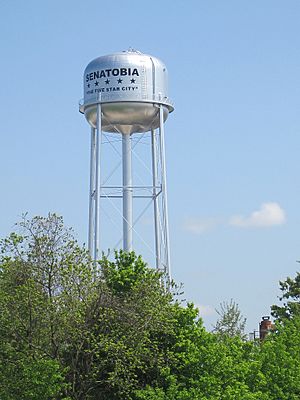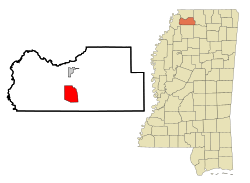Senatobia, Mississippi facts for kids
Quick facts for kids
Senatobia, Mississippi
|
|||
|---|---|---|---|
 |
|||
|
|||
| Motto(s):
The Five Star City
|
|||

Location of Senatobia, Mississippi
|
|||
| Country | United States | ||
| State | Mississippi | ||
| County | Tate | ||
| Chartered | 1860 | ||
| Area | |||
| • Total | 15.64 sq mi (40.51 km2) | ||
| • Land | 15.56 sq mi (40.30 km2) | ||
| • Water | 0.08 sq mi (0.21 km2) | ||
| Elevation | 279 ft (85 m) | ||
| Population
(2020)
|
|||
| • Total | 8,354 | ||
| • Density | 536.96/sq mi (207.32/km2) | ||
| Time zone | UTC-6 (Central (CST)) | ||
| • Summer (DST) | UTC-5 (CDT) | ||
| ZIP code |
38668
|
||
| Area code(s) | 662 | ||
| FIPS code | 28-66440 | ||
| GNIS feature ID | 2405443 | ||
| Highways | |||
| Website | http://www.cityofsenatobia.com | ||
Senatobia is a city in Mississippi, United States. It is the main city, or county seat, of Tate County. Senatobia is also one of the larger towns in the area around Memphis.
In 2010, about 8,165 people lived here. Senatobia is home to Northwest Mississippi Community College. This college offers two-year programs for students.
Contents
History of Senatobia
On April 13, 1834, a person named James Peters bought land from the Chickasaw Nation. He paid $1.25 for each acre. This land later became the town of Senatobia. The town got its name from a nearby stream called Senatobia Creek.
Early Growth and the Railroad
The center of Senatobia, known as the Downtown Senatobia Historic District, started to grow in 1856. This happened after the Tennessee and Mississippi Railroad opened. Because of the easy transportation, people from two nearby towns, Tatumsville and Tatesville, moved to Senatobia.
Becoming a City
Senatobia officially became a city in 1860. During the American Civil War, the business area of the town was burned down twice by Union soldiers. In 1873, after the war, Tate County was formed. Senatobia was chosen as the county seat for this new county.
Geography of Senatobia
Senatobia covers about 10.8 square miles (28 square kilometers). Most of this area is land. Only a small part, about 0.04 square miles (0.1 square kilometers), is water.
Population and People
| Historical population | |||
|---|---|---|---|
| Census | Pop. | %± | |
| 1880 | 935 | — | |
| 1890 | 1,077 | 15.2% | |
| 1900 | 1,156 | 7.3% | |
| 1910 | 1,275 | 10.3% | |
| 1920 | 1,126 | −11.7% | |
| 1930 | 1,264 | 12.3% | |
| 1940 | 1,757 | 39.0% | |
| 1950 | 2,108 | 20.0% | |
| 1960 | 3,259 | 54.6% | |
| 1970 | 4,247 | 30.3% | |
| 1980 | 5,013 | 18.0% | |
| 1990 | 4,772 | −4.8% | |
| 2000 | 6,682 | 40.0% | |
| 2010 | 8,165 | 22.2% | |
| 2020 | 8,354 | 2.3% | |
| U.S. Decennial Census | |||
Senatobia's Population in 2020
In 2020, the census showed that 8,354 people lived in Senatobia. There were 2,470 households and 1,639 families.
| Race | Num. | Perc. |
|---|---|---|
| White | 4,467 | 53.47% |
| Black or African American | 3,367 | 40.3% |
| Native American | 10 | 0.12% |
| Asian | 31 | 0.37% |
| Other/Mixed | 255 | 3.05% |
| Hispanic or Latino | 224 | 2.68% |
Population in 2010 and 2000
In 2010, there were 8,165 people living in Senatobia. This was an increase from 6,682 people in 2000. The city had 2,554 households in 2010.
In 2000, about 38.3% of households had children under 18. About 47.4% of households were married couples. The average household had 2.60 people. The average family had 3.15 people.
The population was quite young. About 24.8% of people were under 18. The average age in the city was 29 years old.
Education in Senatobia
All schools in Senatobia are part of the Senatobia Municipal School District. There is also a private school called Magnolia Heights School.
Notable People from Senatobia
Many interesting people have connections to Senatobia:
- JoJo Billingsley (1952–2010), a rock and roll singer.
- Aron Burton (1938–2016), a blues bass player.
- William J. East (1854–1933), who was a state lawmaker and Mayor of Senatobia.
- Steve Hale (born 1954), a state senator and also a Mayor of Senatobia.
- James "Kamala" Harris (1950–2020), a famous wrestler.
- Sid Hemphill (1876-1963), a bandleader.
- Robert Earl Jones (1910–2006), an American actor.
- O. B. McClinton (1940–1987), a country and R&B singer and songwriter.
- Jacob Buehler Snider (1886–1966), who was the Lieutenant Governor of Mississippi and Mayor of Senatobia.
- Dan A. Sullivan, a politician from Arkansas.
- Elise Varner Winter (1926–2021), who was the First Lady of Mississippi.
Images for kids
See also
 In Spanish: Senatobia para niños
In Spanish: Senatobia para niños




